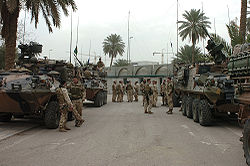
Australian Light Horse were mounted troops with characteristics of both cavalry and mounted infantry, who served in the Second Boer War and World War I. During the inter-war years, a number of regiments were raised as part of Australia's part-time military force. These units were gradually mechanised either before or during World War II, although only a small number undertook operational service during the war. A number of Australian light horse units are still in existence today.

The Royal Australian Regiment (RAR) is the parent administrative regiment for regular infantry battalions of the Australian Army and is the senior infantry regiment of the Royal Australian Infantry Corps. It was originally formed in 1948 as a three battalion regiment; however, since then its size has fluctuated as battalions have been raised, amalgamated or disbanded in accordance with the Australian government's strategic requirements. Currently, the regiment consists of seven battalions and has fulfilled various roles including those of light, parachute, motorised and mechanised infantry. Throughout its existence, units of the Royal Australian Regiment have deployed on operations in Japan, Korea, Malaya, Borneo, Vietnam, Somalia, Rwanda, Cambodia, East Timor, the Solomon Islands, Iraq and Afghanistan.

The Royal Australian Armoured Corps (RAAC) is an administrative corps of the Australian Army. It provides the Australian Defence Force's Armour capability, which performs the function of mounted combat. Armour combines firepower, mobility, protection and networked situational awareness to generate shock action and overmatch in close combat. Armour is an essential element of the combined arms approach that is employed by the Australian Army.

The 4th Battalion, Royal Australian Regiment was an infantry battalion of the Australian Army, forming part of the Royal Australian Regiment and eventually Special Operations Command. The battalion was formed on 1 February 1964, converted to a special forces unit on 1 February 1997, and was renamed the 2nd Commando Regiment on 19 June 2009.

This article describes the current structure of the Australian Army. It includes the army's order of battle and the headquarters locations of major units. Members of the Australian Army also serve within joint units of the Australian Defence Force which fall outside the direct command of the Australian Army.

7th Brigade is a combined arms formation or brigade of the Australian Army. The brigade was first raised in 1912 as a Militia formation, although it was re-formed as part of the First Australian Imperial Force in early 1915 for service during World War I. It subsequently saw action at Gallipoli and on the Western Front during the war. Following the end of the war the brigade was disbanded in 1919 before being re-raised in 1921 as part of the Citizens Force. During World War II the brigade took part in the fighting against the Japanese in New Guinea and on Bougainville. Today, the 7th Brigade is part of 1st (Australian) Division and is based in Brisbane, Queensland and is composed mainly of units of the Regular Army. While the brigade has not deployed as a whole unit since World War II, component units have deployed on operations to East Timor, the Solomon Islands, Iraq and Afghanistan.

6th Battalion, Royal Australian Regiment is a mechanised infantry battalion of the Australian Army. It was originally raised in Brisbane, Queensland, on 6 June 1965 and has since then served in a number of overseas deployments and conflicts including South Vietnam, East Timor, Iraq and Afghanistan. During the Vietnam War, the battalion earned a US Presidential Unit Citation from the United States when members from 'D' Company participated in the Battle of Long Tan on 18–19 August 1966. The battalion is currently based at Gallipoli Barracks in Brisbane and forms part of the 7th Brigade.
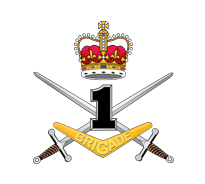
1st Brigade is a combined arms formation of the Australian Army. Formed in 1903 as a militia formation based in New South Wales, it was reconstituted as part of the Australian Imperial Force in 1914 for service during World War I, the brigade fought at Gallipoli and on the Western Front before being disbanded in mid-1919. In 1921, the 1st Brigade was re-raised as a unit of Australia's part-time military forces, based in New South Wales. During World War II the brigade undertook defensive duties before being disbanded. In 1948, it was re-raised as an integral part of the Australian Regular Army. Currently the brigade is based at Robertson Barracks in Darwin and at RAAF Base Edinburgh near Adelaide, South Australia. It is the first of the Australian Army brigades to be re-organised as a combat brigade under Plan Beersheba.

The 5th/7th Battalion, The Royal Australian Regiment (Mechanised) was a mechanised infantry battalion of the Australian Army. The battalion was based at Robertson Barracks in Holtze, Northern Territory and formed part of the 1st Brigade. It was formed in 1973 by linking both the 5th and 7th Battalions of the Royal Australian Regiment together and was disbanded 3 December 2006, as part of the expansion of the Australian Army, when the 5th and 7th Battalions of the Royal Australian Regiment were delinked into two separate battalions once again.

The 3rd Battalion, Royal Australian Regiment is a mechanised infantry battalion of the Australian Army, based in Kapyong Lines, Townsville as part of the 3rd Brigade. 3 RAR traces its lineage to 1945 and has seen operational service in Japan, Korea, Malaya, Borneo, South Vietnam, Rifle Company Butterworth, East Timor, the Solomon Islands, Afghanistan and Iraq.

1st Battalion, Royal Australian Regiment is a regular motorised infantry battalion of the Australian Army. 1 RAR was first formed as the 65th Australian Infantry Battalion of the 34th Brigade (Australia) on Balikpapan in 1945 and since then has been deployed on active service during the Korean War, the Malayan Emergency, the Vietnam War, Unified Task Force in Somalia, East Timor, Iraq War and Afghanistan. Additionally, the battalion has deployed on peacekeeping and other operations to a number of countries including Japan, Rifle Company Butterworth, Timor Leste, Solomon Islands, Tonga and the Philippines. 1 RAR remains one of the Australian Army's most readily deployed units sending individuals and detachments to domestic, regional and other enduring operations. The battalion is currently based in Coral Lines at Lavarack Barracks, Townsville, Queensland, where it forms part of the 3rd Brigade.

The Australian 34th Brigade was an Australian Army brigade. The brigade was formed in late 1945 following the end of World War II as part of the Australian contribution to the British Commonwealth Occupation Force (BCOF) in Japan. In late 1948 it was renamed the 1st Brigade.
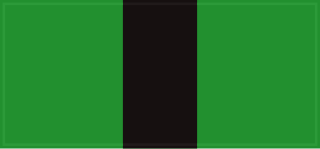
The 2nd Battalion, Royal Australian Regiment is an amphibious light infantry battalion of the Australian Army part of the 1st Division Amphibious Task Group based at Lavarack Barracks in Townsville.
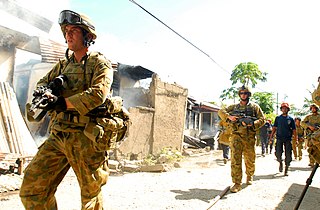
Operation Astute was an Australian-led military deployment to East Timor to quell unrest and return stability in the 2006 East Timor crisis. It was headed by Brigadier Bill Sowry, and commenced on 25 May 2006 under the command of Brigadier Michael Slater. The operation was established at the request of East Timor's government, and continued under an understanding reached between Australia, East Timor, and the United Nations, with the United Nations Integrated Mission in East Timor supporting and helping to develop East Timor's police force. Other countries deploying soldiers to East Timor include Malaysia, New Zealand and East Timor's former colonial power Portugal, operating under independent command.
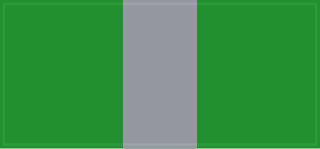
The 8th/9th Battalion, Royal Australian Regiment is a motorised infantry battalion of the Australian Army. It was originally formed in 1973 by linking together both the 8th and 9th Battalions of the Royal Australian Regiment. Over the next twenty-four years the battalion would remain on the Australian Order of Battle based at Enoggera Barracks in Brisbane, Queensland, until it was disbanded in 1997 amid a number of Defence-wide cutbacks introduced by the Howard government. In 2006 it was announced that the battalion would be re-raised as part of a plan to expand the size of the Army and since then it established itself as a fully deployable motorised infantry battalion as part of 7th Brigade.
The 4th Regiment, Royal Australian Artillery is an artillery unit of the Australian Army. Currently it provides close artillery support to the 3rd Brigade and is based at Chau Pha Lines, Lavarack Barracks in Townsville, Queensland. The regiment was raised in its current form in 1960 and is currently re-equipping with M777A2 lightweight towed howitzers. The regiment deployed during Australia's commitment to the Vietnam War and has subsequently deployed to Singapore and East Timor.

The 7th Battalion, Royal Australian Regiment is a regular infantry battalion of the Australian Army. It was originally raised in 1965 as part of Australia's commitment to the Vietnam War and it eventually served two tours in Vietnam in 1967 and 1971. In 1973, following Australia's withdrawal from the conflict, the battalion was amalgamated with the 5th Battalion, Royal Australian Regiment to form the 5th/7th Battalion, Royal Australian Regiment.

The 11th Brigade is an Australian Army brigade which currently comprises most Australian Army Reserve units located in Queensland. The brigade was first formed in early 1912 following the introduction of the compulsory training scheme. Later, as part of the 3rd Division and saw action during World War I on the Western Front as part of the First Australian Imperial Force. In the interwar years, the brigade was re-raised with its headquarters in Brisbane.

The 1st Light Horse Brigade was a mounted infantry brigade of the Australian Imperial Force (AIF), which served in the Middle Eastern theatre of World War I. The brigade was initially formed as a part-time militia formation in the early 1900s in New South Wales and then later in Queensland. In 1914, the brigade was re-constituted as part of the AIF and was sent to Egypt. Forming part of the New Zealand and Australian Division, during the Gallipoli Campaign it served in a dismounted role between May and December 1915. After being withdrawn to Egypt it served in the Anzac Mounted Division from March 1916 as part of the Egyptian Expeditionary Force, taking part in the Sinai and Palestine Campaign until the end of the war. It was disbanded in 1919. After the war, the AIF light horse regiments were demobilised and disbanded; however, the brigade briefly existed as a part-time militia formation in Queensland until 1921 when its regiments were reorganised into cavalry brigades.

The 11th Light Horse Regiment was a mounted infantry regiment of the Australian Army during the First World War. The regiment was raised in August 1914, and assigned to the 4th Light Horse Brigade. The regiment fought against the forces of the Ottoman Empire, in Egypt, at Gallipoli, on the Sinai Peninsula, and in Palestine and Jordan. After the armistice the regiment eventually returned to Australia in March 1919. For its role in the war the regiment was awarded fourteen battle honours. During the inter-war years, the regiment was re-raised as a part-time unit based in the Darling Downs region of Queensland. It was later converted to a motor regiment during the Second World War but was disbanded in 1943 without having been deployed overseas.
